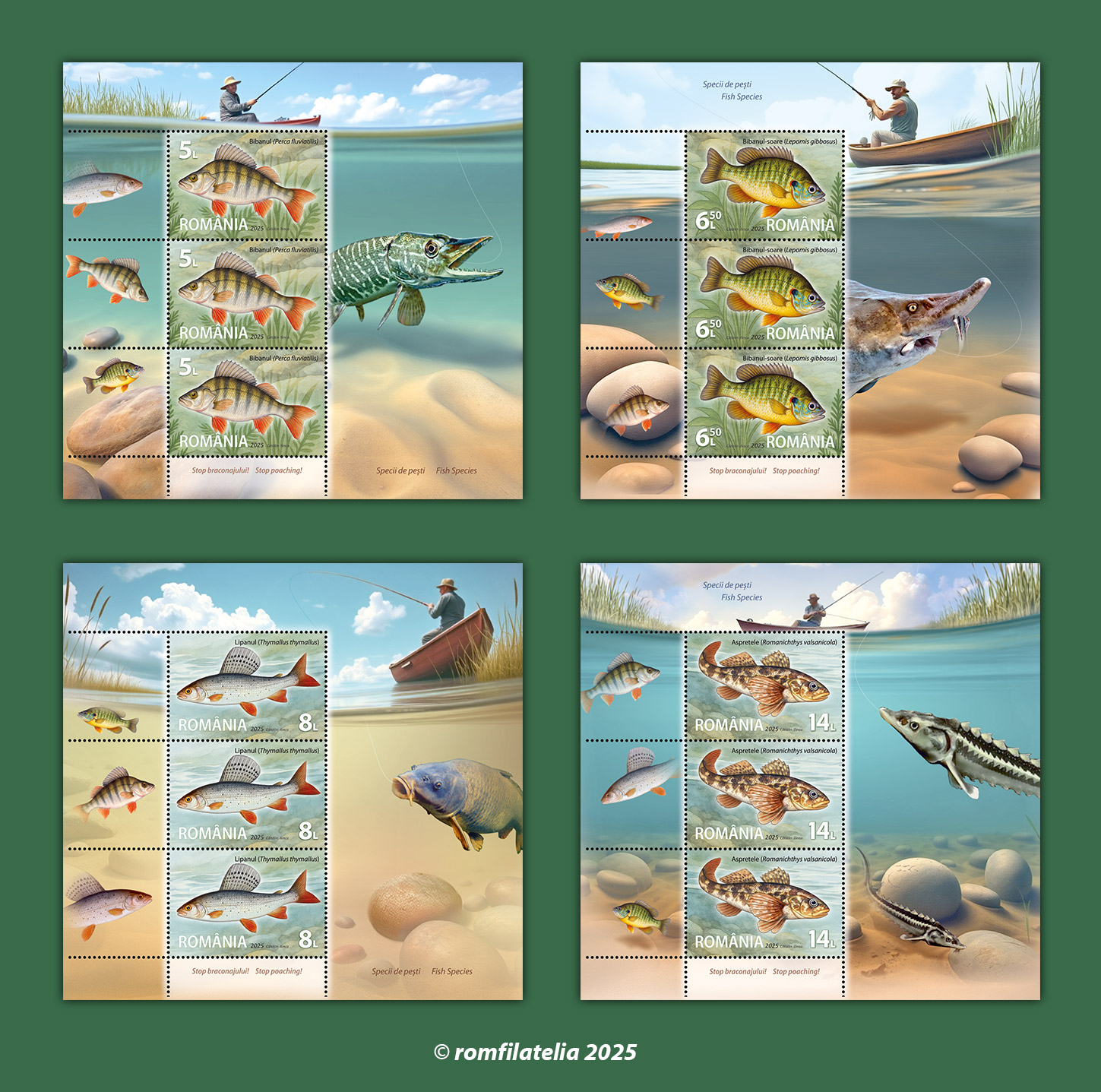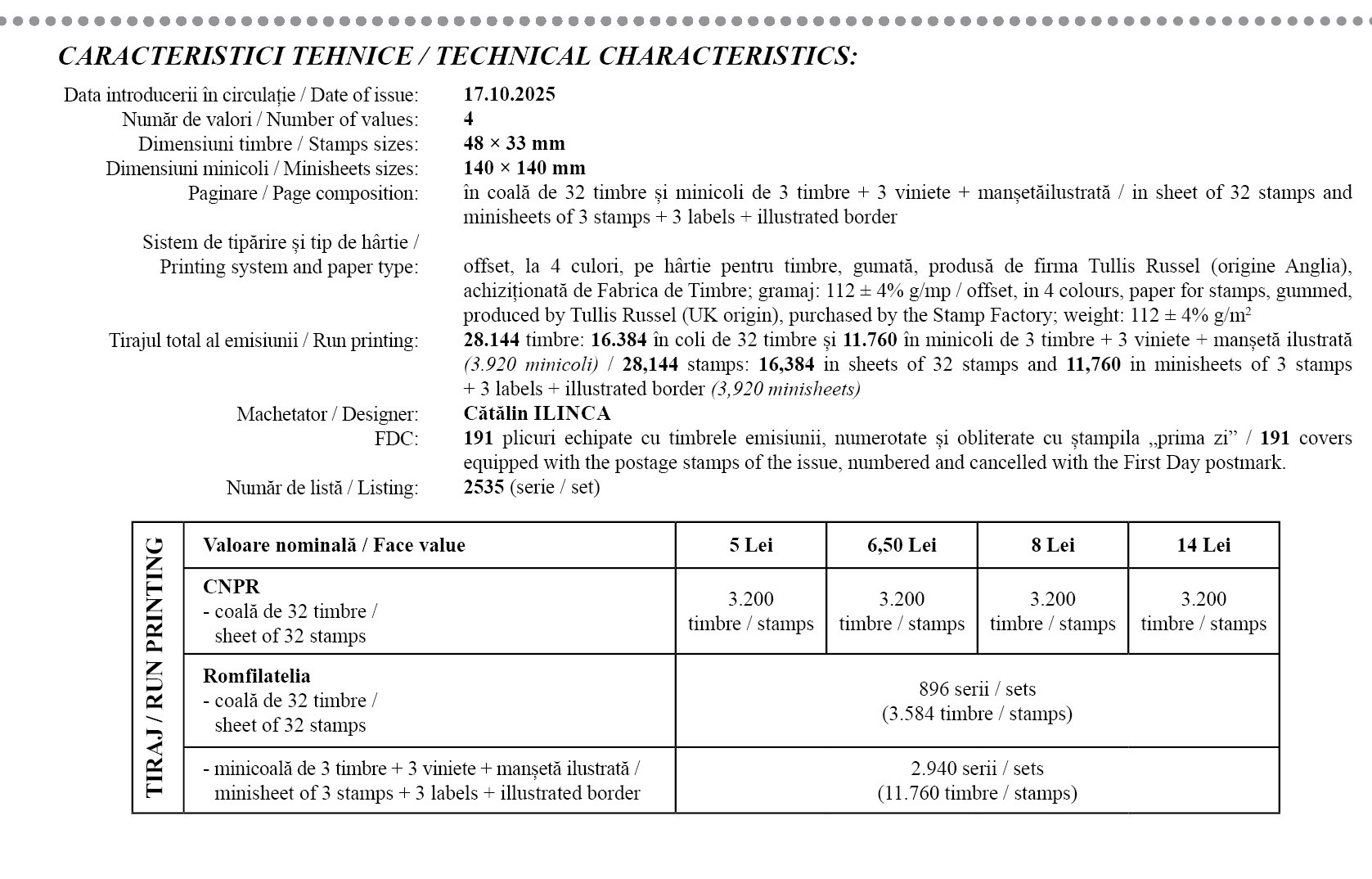 Romfilatelia and Poșta Română introduce into circulation on Friday, Octomber 17th, this year, a postage stamp issue on the theme Fauna, under the generic title FISH SPECIES.
Romfilatelia and Poșta Română introduce into circulation on Friday, Octomber 17th, this year, a postage stamp issue on the theme Fauna, under the generic title FISH SPECIES.
The issue consists of four postage stamps and a First Day Cover.
Well-known living creatures, fish are vertebrate, craniate animals that live in aquatic environments, breathing oxygen dissolved in the water through their gills. The science of studying fish is called Ichthyology.
The body of fish is most often fusiform, hydrodynamically constructed, but may also be dorsoventrally (e.g., the catfish) or laterally (e.g., the flattened heel) flattened, or variously shaped (e.g., the seahorse). It may be covered with protective scales or bony plates of dermal origin – or gilled.
The coloration of fish is determined by chromatophores, cells under the skin that contain granules of pigment.
The eyes of fish have a complete globular structure; most fish have no eyelids, but some have an adipose eyelid (e.g., mackerel, mullet…), or a so-called nictitating, protective membrane (e.g., most sharks). Most fish accommodate vision by shifting the lens (not by changing its curvature as in birds and mammals).
Fish gills are respiratory organs capable of taking oxygen from the water. In most bony fish, there are five pairs of gills arranged on the sides of the head, housed in gill chambers and covered by bony caps (opercula).
Fish are an important source of food. In addition to the quantities caught in open waters, fish are also farmed. Aquaculture, which is growing steadily, tends to overtake traditional fisheries.
It is worth noting that the postage stamps illustrate species of freshwater fish. In Romania, among the best-known species of freshwater fish are: the trout, the zander, the pike, the catfish, the perch, the bream, the ruffe, the crucian carp, the chub, and the carp.
The Perch (Perca fluviatilis) shown on the postage stamp with the face value of Lei 5, is a widely fished freshwater predator. It has a body covered with ctenoid scales (sharp due to the serrations suggesting a comb). It is widespread in lakes and freshwaters of the northern hemisphere (it has been declared the national fish of Finland). It feeds on invertebrates and small fish and is often caught and eaten.
The Pumpkinseed (Lepomis gibbosus), also known as the queen of the pond or sorete, pictured on the postage stamp with the face value of Lei 6.50, is a species native to North America, successfully acclimatized in Europe. It can be found in lakes, ponds, smooth flowing waters, including the Danube Delta. It has a beautiful and attractive coloration. It feeds on invertebrates, fish eggs and juveniles. Although it is fished, it is not among the most popular species.
The European grayling (Thymallus thymallus) depicted on the postage stamp with the face value of Lei 8. Widespread in the northern and central parts of Europe, the European grayling is, in Romania, a species of deep, clean and cold mountain streams. It eats aquatic insects, small fish and sometimes vegetable matter. Popular with anglers but threatened by pollution, construction and poaching, it is an endangered species in Romania.
The Sculpin-pearch (Romanichthys valsanicola) pictured on the postage stamp with the face value of Lei 14, is a sweet-spotted fish of fast mountain waters. At present it is found only on a portion of the Vâlsan River. Endemic in Romania, critically endangered, under strict protection, it is one of the rarest fishes in Europe (and probably in the world).
The First Day Cover depicts a suggestive underwater environment with various species of freshwater fish, in a setting where water and plants provide a defining image of the subject of the postage stamp issue.
Romfilatelia thanks Scientific Researcher Grade I Luis Ovidiu Popa, the Manager of the ‘Grigore Antipa’ National Museum of Natural History, and to museum curator Alexandru Iftime, Ph.D. for their expert consultancy provided in the development of this postage stamps issue.









